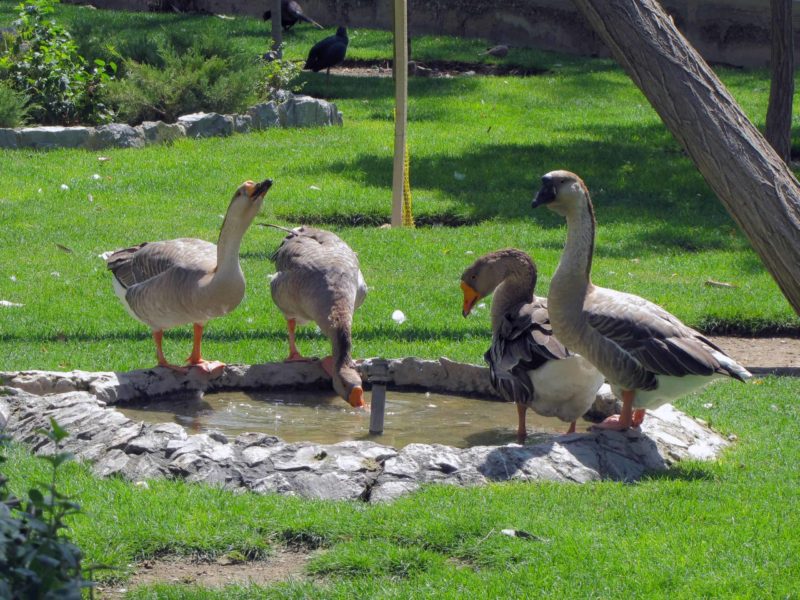
Updated April 16, 2021
Enrichment is often thought of as an extra or optional provision for residents. Sanctuary workers are understandably focused on providing the food, water, and housing that is necessary for residents to live. However, we are hoping that by incorporating enrichment as an aspect of general care, the lives of residents will be enriched. This is of particular importance for residents residing in smaller, more confined, or barren living spaces. In areas that experience intense cold, the best way to keep geese residents warm is to leave them in a smaller, coop-like space when they may normally have a larger outdoor space for grazing, a pond for swimming and bathing, and other geese behaviors. In cases like these, enrichment can make a world of difference in the lives of residents. No one likes to be bored, including residents, regardless of species!
Developing An Enrichment Plan
It is important to understand the species-specific needs of your residents, as well as to consider their individual needs. An example of a species-specific understanding acknowledges that geese are very motivated to graze. Many studies regarding enrichment for domesticated birds have focused on chickens, including some showing that chickens are stimulated by visual enrichment, particularly those involving movement. While there is some information specifically on geese enrichment, there is quite a lot more for chickens. That being the case, many of the suggestions included in this article have been modified from informational resources for chickens.
When developing an enrichment plan for residents, it is important to consider the types of behavior in which you are hoping to see an increase or decrease. For example, if you are hoping to reduce feather-picking, there are particular enrichment options that are ideal for that, such as tying a bunching of white string to an accessible part of their living space. Do you want to increase exploratory behavior? Novel objects and nutritional foraging enrichment may be better suited in this case. We know you likely have your hands full managing a sanctuary; developing an enrichment plan for species, particular groupings, and individuals could potentially help you save time and money in the future!
In this resource, we will go into different types of enrichment and how they can be implemented at your sanctuary. The great news is that there are many inexpensive ways to provide enrichment for your residents!
Highly Pathogenic Avian Influenza
Due to the growing danger of HPAI great care must be taken to ensure bird residents do not come into contact with wild birds or with water or food or other resources that wild birds have access to. This means that you may have to get extra creative in terms of enrichment to avoid potential transmission. Learn more about HPAI and how you can protect bird residents here.
What An Enrichment Plan Could Look Like
The best way to start any enrichment plan is to first consider natural behaviors. For example, in the wild, geeseUnless explicitly mentioned, we are referring to domesticated goose breeds, not wild geese, who may have unique needs not covered by this resource. spend most of their day moving about and grazing. It’s important to understand both the species-specific needs of your residents in addition to considering their individual needs!
“Queenie the goose underwent surgery recently and their movements must be limited, especially walking, for the next week or two. Setting Queenie up in a sling or small living space and providing enrichment as a means of mental stimulation can assist in their healing. Examples of possible enrichment strategies for Queenie include playing the radio, stringing a treat garland within their reach, and adding a familiar smell to their temporary living space. Other options include providing hanging parrot toys for them to explore or providing a stuffed animal, particularly if they are young. A pool would not be appropriate enrichment during that time but a bowl of water with treats could provide mental stimulation.”
Sample Enrichment Plan
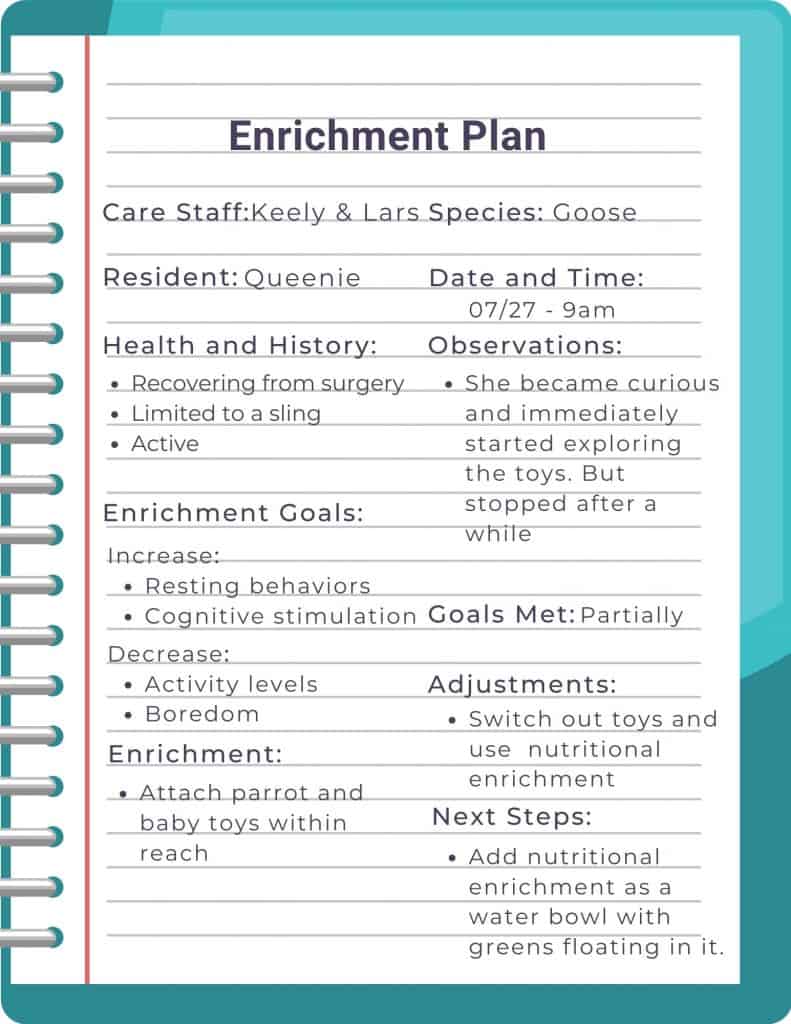
Enrichment can go beyond just offering toys or treats- and that offering enrichment isn’t just a one-time thing! Residents will become bored with certain enrichment that is left in their living spaceThe indoor or outdoor area where an animal resident lives, eats, and rests. for an extended period, or the same enrichment offered every day (tasty treats being likely an exception to this).
One At A Time!
It is important to only add a single enrichment element at a time when you are first observing and learning whether a resident(s) actually finds it enriching (and for how long they find it enriching before they lose interest). Adding multiple enrichment strategies makes it difficult to get an accurate assessment of the appropriateness of the chosen enrichment. You will be better able to build a schedule when you have more accurate information.
Now that we have covered what an individual enrichment plan looks like, we will cover some of the different types of enrichment for geese and how they could be implemented at your sanctuary.
Observations And Adjustments Are Key!
It’s always important to observe if and how residents use the proffered enrichment. Remember, it is only enrichment if the individual finds it enriching! If they are frightened by something or uninterested in it, then it isn’t enriching.
Social Enrichment
This one may seem obvious but it is important to mention: Geese are social animals and it is important they have access to other geese. Of course, there are times when this isn’t possible, due to medical issues, flock disagreements, or sadly, the death of their flock mates. In cases like these where direct contact with others of their species isn’t possible, there are ways that can enrich their lives during this time.
- If at all possible, geese should be housed with other geese. If this is not possible, then extra steps should be taken to alleviate the stress caused by their isolation.
- Provide visual contact with other geese.
- Adding a mirror (some places hang old CDs) to their living space.
- Including a small amount of soiled bedding (if contagion isn’t an issue) from their original flock space.
- Play a recording of normal geese sounds.
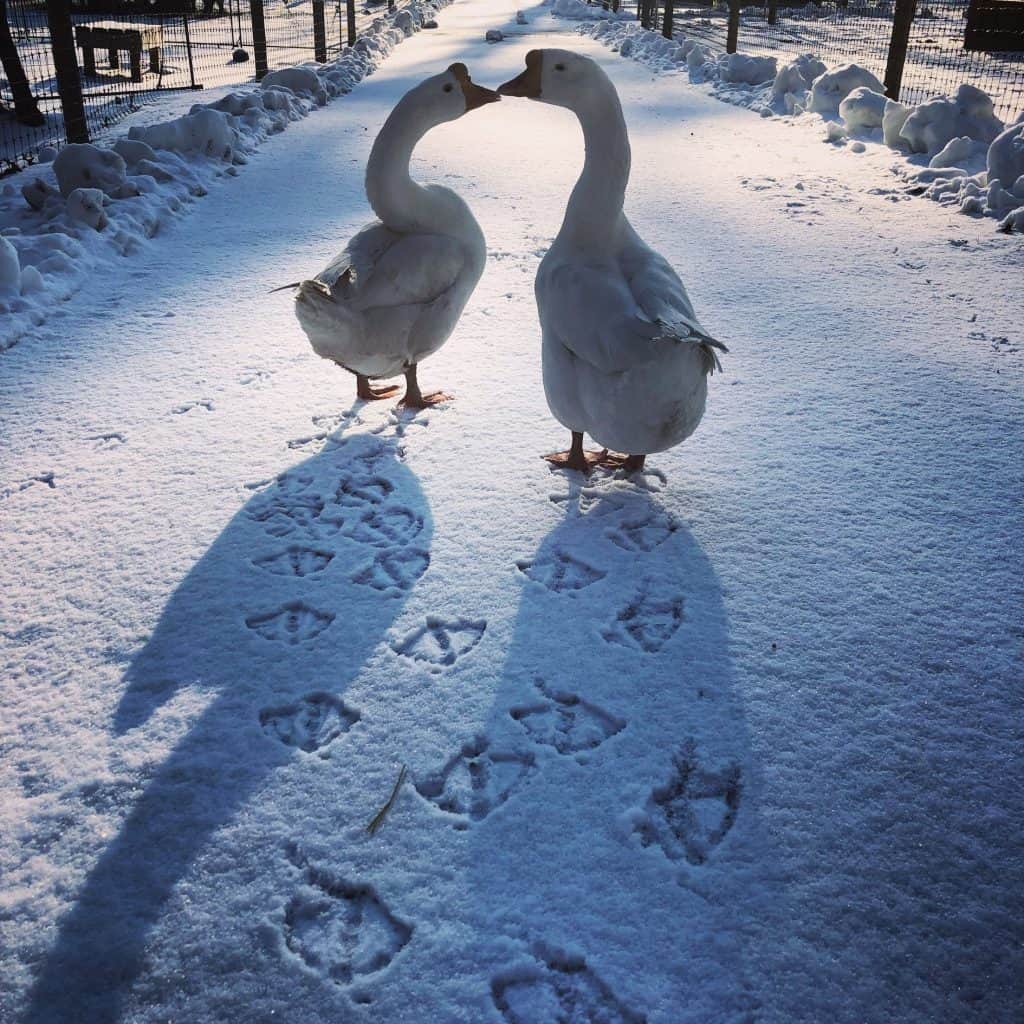
Photo: Unity Farm Sanctuary
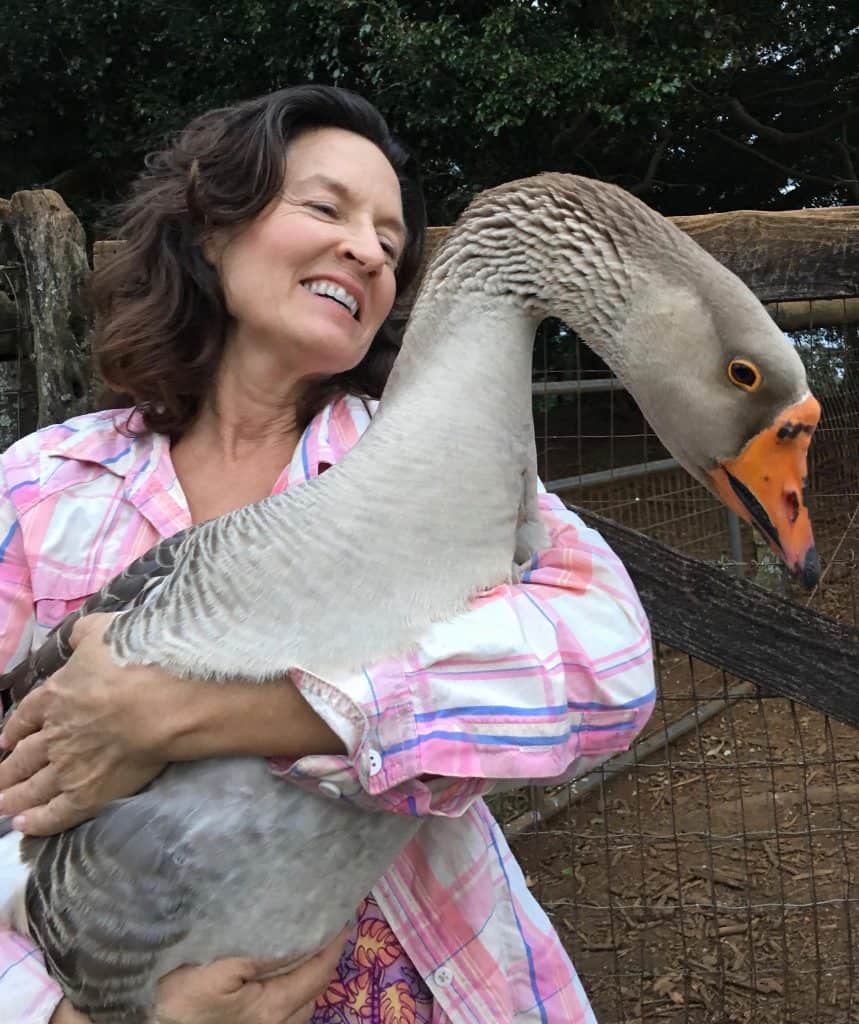
Physical Enrichment
Physical or structural enrichment refers to creating a dynamic living space for residents. This is where you should think about what your resident as a species and individual would want in a living space. Check out our Animal-Centered Design resource to learn more about this. Let’s look at some goose-specific physical enrichment:
- Providing multiple water and food “stations”.
- Provide nice grassy areas, bushes, and other duck-safe plants.
- Offer multiple nesting materials and substrates like straw, leaves, and even fresh piles of dirt of goose-safe mulch.
- Set up temporary fencing in a way that encourages them to make use of their outdoor living space and allow access to other areas on a schedule
- Make sure they have access to a pool, puddle, safe pond, and other water features.
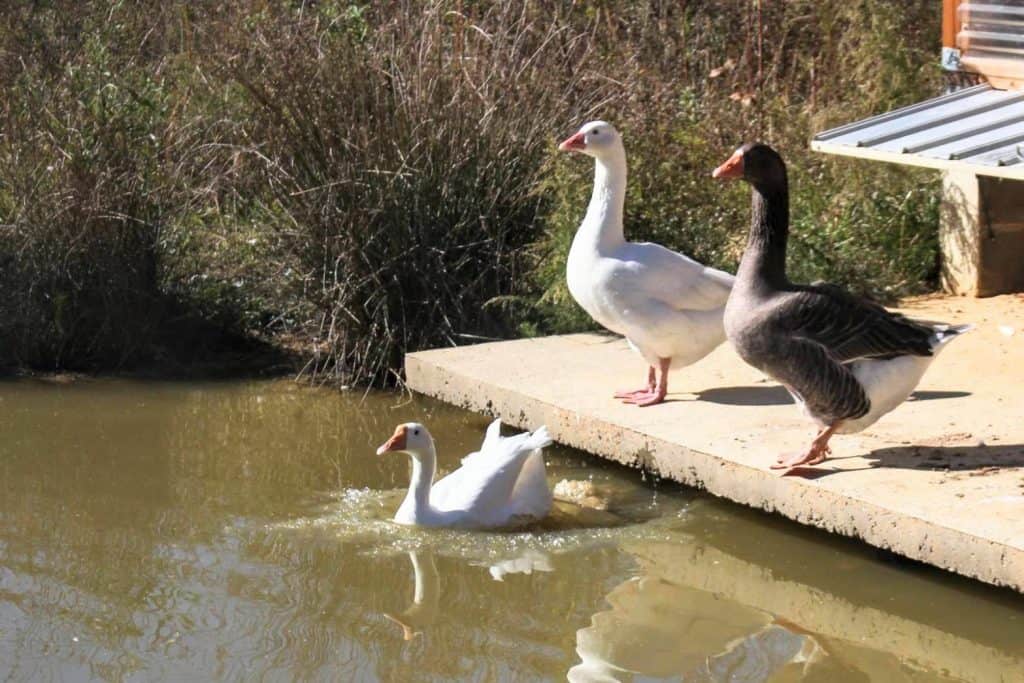
Photo: Piedmont Farm Animal Rescue
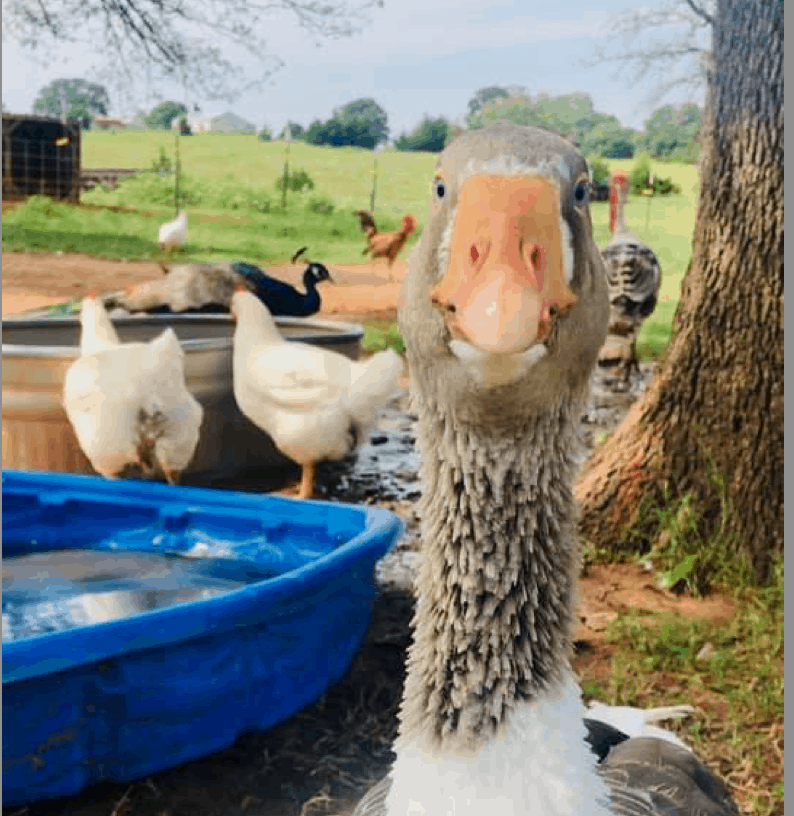
Nutritional Enrichment
This is a fun one! We all know geese enjoy grazing and enjoy an array of tasty treats.
Here is a list of ideas for nutritional enrichment for your geese residents:
- Geese are grazers and love new grass. You can give them new grass and goose safe plants to graze on.
- Take a two to-three-inch wide PVC pipe and put caps on the ends. The length of the tube could be a foot long or larger. Drill a handful of holes on the side of the tube and it becomes a food dispenser when the birds roll and peck at it.
- Another option is to place a goose’s food in wiffle balls. As the balls roll, treats fall out. Or, you can hang the wiffle balls.
- Some puzzle feeders made for dogs can be used with supervision.
- Provide forage boxes, or fence off an area inside their enclosure and plant goose-safe plants, then remove the barrier and let them forage in the new space.
- Hang heads of cabbage or lettuce from a string or in a ball basket, making a tasty treat piñata! We recommend covering the string with stiff tubing or a piece of hose to prevent residents from getting tangled in the string.
- Add a pile of leaves (be sure they aren’t toxic to geese) and sprinkle treats throughout.
- String produce and make a garland to hang in their living space.
- When temperatures are hot, add chopped up produce to a mold, add water and freeze, creating a cool treat that can keep your residents engaged on a hot day.
Check out our resource on safe treats for geese residents!
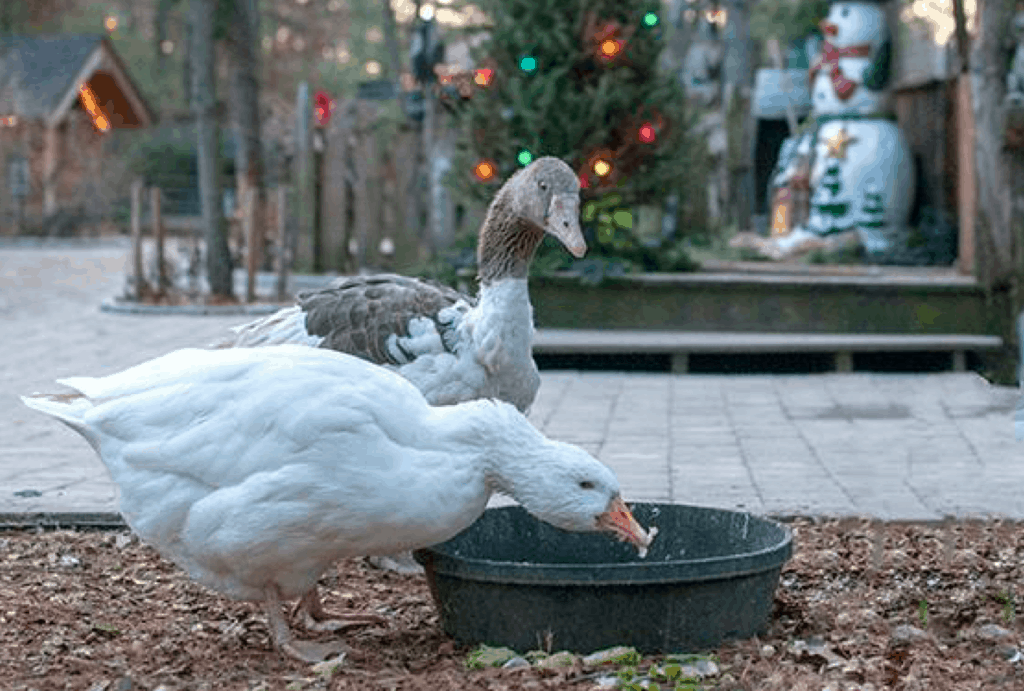
Photo: Sheepish Grin Photography
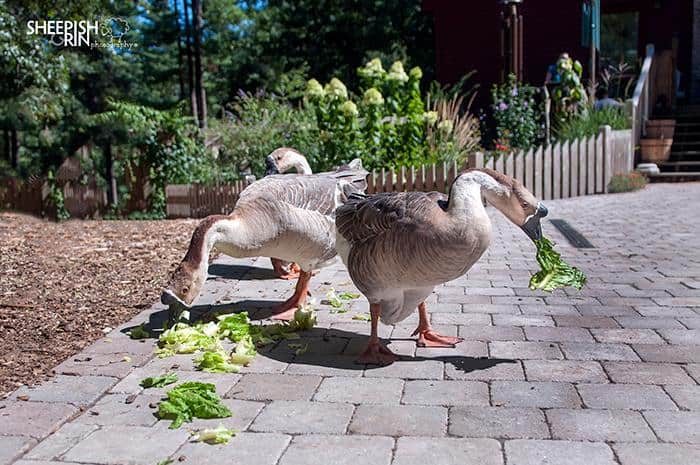
Photo: Sheepish Grin Photography
Sensory Enrichment
Sensory enrichment refers to enrichment that engages the senses. Arguably all enrichment engages the senses, but sensory enrichment focuses in on sight, touch, hearing, and smell. Each can provide interesting experiences for residents!
Visual Enrichment
Research has shown that chickens can benefit from visual forms of enrichment. In particular, studies revealed that chickens that have been given visual forms of enrichment exhibit less fear when they are transferred to unfamiliar environments. It is quite possible that this is true for geese as as well though further study is needed.
- Computer screen savers, particularly those that move.
- Television or movies
- Images of chickens projected onto walls has shown behavioral imitation among the flock it is shown to. So projecting scenes of happy geese may help your resident geese feel good too. Interest in images can fade after a few weeks and so should be changed routinely to sustain interest.
- Provide mirrors (Observe carefully to ensure they don’t find their reflection upsetting) or hang CDs around enclosure.
- Place a pinwheel around their living space.
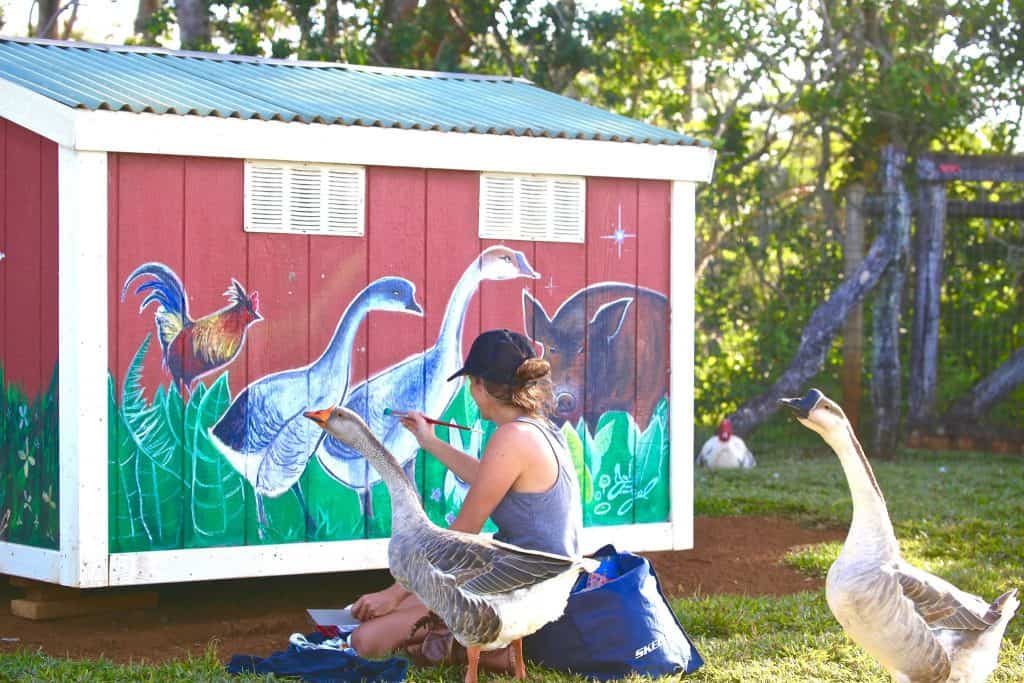
Photo: Leilani Farm Sanctuary of Maui
Olfactory Enrichment
Olfactory enrichment is often overlooked when considering geese. However, studies have shown that many domesticated birds have a developed sense of smell, and providing geese access to certain smells may contribute to feelings of safety. If you need to transfer a goose to a new living space, add a bit of soiled bedding from their previous space.
Other olfactory enrichment opportunities may include:
- Lightly bury goose-safe herbs around their living space.
- Chicks have been shown to prefer smells like vanilla over garlic.
- Chicks exposed to geranium oil exhibited an increase in pecking, vocalization, preening, and movement.
- If introducing new birds to an existing flock, the presence of vanilla scent may have a calming effect if both living spaces where the birds resided had vanilla in them as well.
Auditory Enrichment
Do you love a good tune? Or have a favorite song that soothes you? The same can be true for geese! While so much of the research refers specifically to chickens, it may provide a place to start thinking of auditory enrichment opportunities for geese.
- Chickens have been shown to experience reduced fear when played classical music!
- Other studies have shown that playing a radio for hens made them calmer.
- Natural sounds for chickens work but are not as helpful as music can be for brain growth.
Tactile Enrichment
To encourage geese to interact with their environment and redirect otherwise problematic behavior, consider adding tactile enrichment to their living spaces. This might include:
- Add nest building materials such as sticks and reeds to the enclosure.
- Plant long grasses or shrubs around their living spaces.
- Geese enjoy water. Healthy adult residents should have access to a pool or source of open water where they can bathe and swim. It is important they can safely and easily enter and exit the water. Goslings should not be left in water longer than 20 minutes and should be supervised to prevent drowning. Alternatively, you can provide a shallow dish with stones or balls that allow them to play in the water without risk of drowning.
- Tying a bunch of thick white strings in their living space. (Be sure they cannot remove and swallow them!)
- Adding colorful balls (large enough that they can’t swallow them, and made from material they cannot digest) to food dishes.
- Parrot toys and goose-safe baby toys can be hung around the enclosure for investigation.
- Adding multiple types of goose-safe substrates to their outdoor living space and see which one they are most drawn to. (Although they don’t roost like chickens, providing places to sit and explore at different heights can be enriching)
- Adding unique roosting opportunities. However, it is important to consider the needs of your individual residents. Structures that are higher up may not be advisable for seniors and geese with special medical issues.
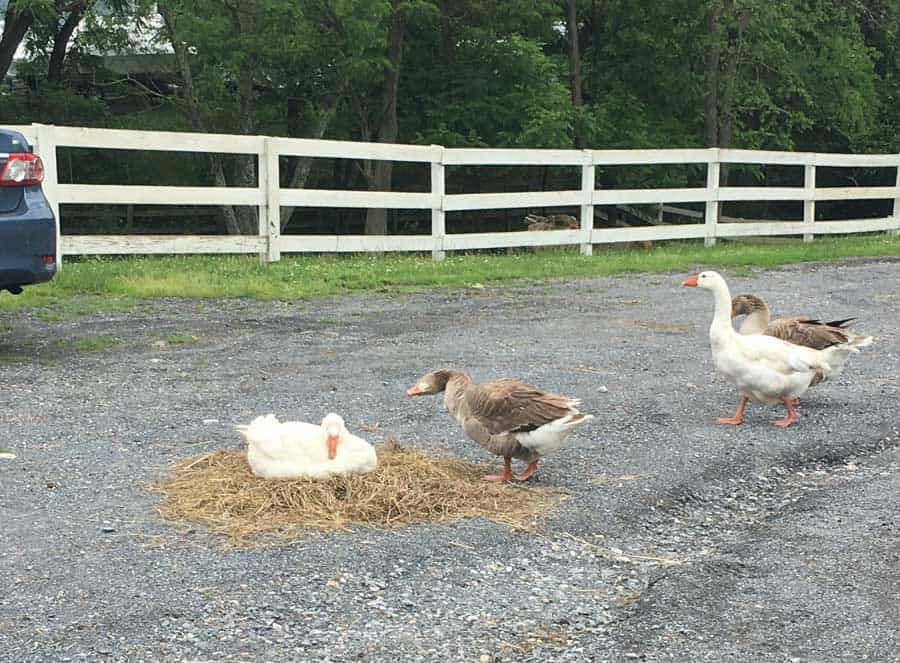
Photo: Star Gazing Farm Animal Sanctuary
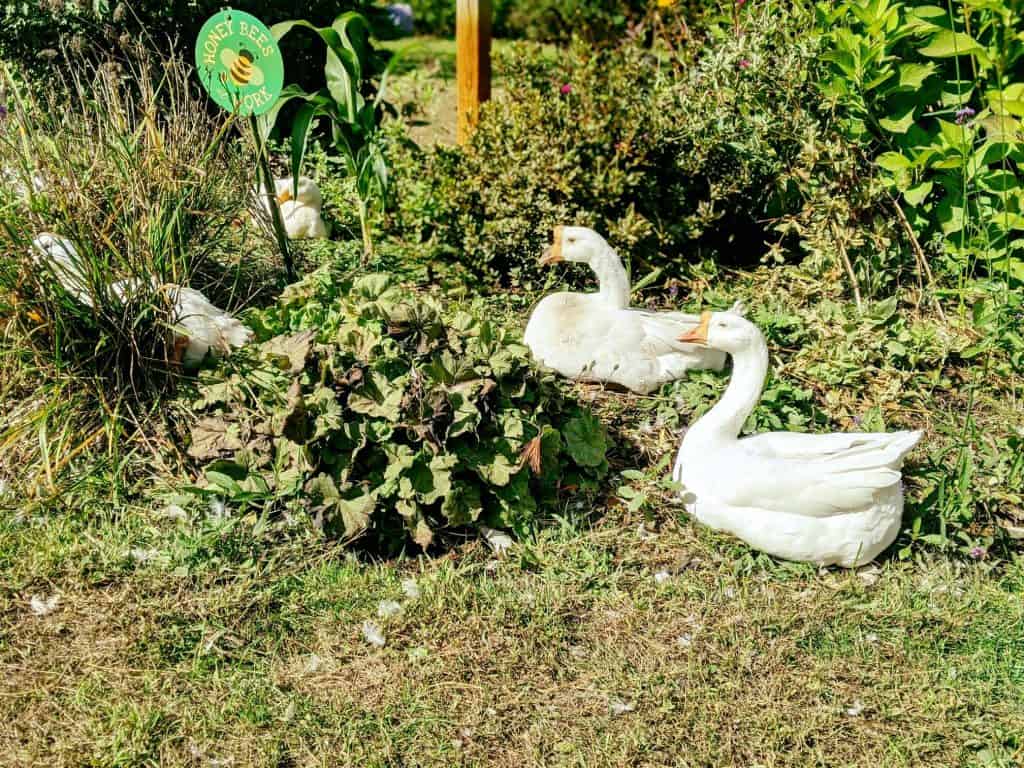
Cognitive Enrichment
Cognitive enrichment involves experiences or environments that encourage curiosity, problem solving behaviors, and learning. A number of enrichment strategies listed above also fall into this category. Puzzle feeders and engaging with curious things in their environment are examples. But lets touch on another form of cognitive enrichment: positive reinforcement learning (This is often referred to as “training”, but we like to refer to it as clicker “learning”, “play” or “bonding”)-
- Positive Reinforcement Engagement
- Some geese may enjoy interacting with their human caregivers. One way to build a strong human-goose bond and boost cognitive functioning in your geese residents is to engage in clicker “learning”. Clicker learning and positive reinforcement are not interchangeable words. However, a clicker can be a useful tool during positive reinforcement engagement!
- Examples of activities to learn with your geese residents could include learning to choose a specific shape or color of an object or ring a bell, rewarding them with an immediate click and treat. Other examples include learning to push a rubber ball or solving puzzles for treats (exercise and engagement),and even move through agility courses (you can often make a simple agility course with things you already have on hand or by getting inexpensive supplies), or even to ease fear or reactivity to medical procedures.
Focus On The Resident
It is important to note that clicker learning or play should only be implemented for the positive experiences that can be provided to your residents. This should not be used to encourage behavior that might be unsafe or exploitative.
This infographic from Poultry DVM provides a brief tutorial on how to clicker train.
Take Notes
Because every goose is an individual, they are likely to have individual responses to enrichment. When you first add enrichment items, be sure to carefully observe the reactions of your residents. To prevent discomfort from new items or enrichment schedules, consider adding novel objects to an area at the side of their living space, or in a space that doesn’t require them walking past the item to go inside, outside, or reach their water or food. If you believe one of your resident flocks or individuals may be fearful of certain enrichment, encouraging them to investigate object while you are sitting and holding the object can help ease fears. Using food or treats to motivate them to interact with the item is a great way to start. Giving your residents the option to engage or not with enrichment items can be empowering and improve emotional states. Be sure to make notes of any reactions and when their level of interest seems to subside. This will help you know how to best schedule days to change up their enrichment and provide them with a mentally stimulating environment.
Novelty
Novelty can be enriching on its own. Making changes to the “furniture”, arrangement, placement of food, and the addition of balls, toys, and swings, can all create an interesting and enriching environment for your goose residents. Geese are clever and become bored after some time with provided enrichment. For this reason, it is important to incorporate “switch it up” days into your residents’ enrichment schedules. As mentioned above, it is important to take notes on flock and individual responses so you can properly tailor enrichment to the interests and needs of your residents.
Building A Schedule
Once you learn more about your residents’ interests, you can build an enrichment schedule to provide varying forms of enrichment as part of your care-taking routine. This will keep things interesting for the geese and help provide a stimulating and happy life for your residents.
Do you have an exciting enrichment strategy you use with your geese? Tell us all about it!
SOURCES:
Backyard Poultry Medicine And Surgery: A Guide For Veterinary Practitioners
The Effects Of Environmental Enrichment Devices On Feather Picking In Commercially Housed Pekin Ducks | Poultry Science (Non-Compassionate Source)
Enrich Your Chickens’ Environment For Better Health | Hobby FarmsFor-profit organizations focused on the production and sale of plant and/or animal products. (Non-Compassionate Source)
Environmental Enrichment Ideas For Poultry | Poultry DVMDoctor of Veterinary Medicine, an academic degree awarded to veterinarians in many countries. (Non-Compassionate Source)
Do You Need Toys For Chickens? | Backyard Poultry (Non-Compassionate Source)
Music | Poultry DVM (Non-Compassionate Source)
Familiar Smells | Poultry DVM (Non-Compassionate Source)
Colorful Balls | Poultry DVM (Non-Compassionate Source)
Mirror | Poultry DVM (Non-Compassionate Source)
Environmental Enrichment For Poultry Welfare | British Society Of Animal Science (Non-Compassionate Source)
The Effects Of Four Types Of Enrichment On Feather-Pecking Behaviour In
Laying Hens Housed In Barren Environments | Animal WelfarePractices and policies that promote the well-being of nonhuman animals, specifically their health and comfort. (Non-Compassionate Source)
If a source includes the (Non-Compassionate Source) tag, it means that we do not endorse that particular source’s views about animals, even if some of their insights are valuable from a care perspective. See a more detailed explanation here.








